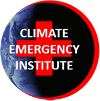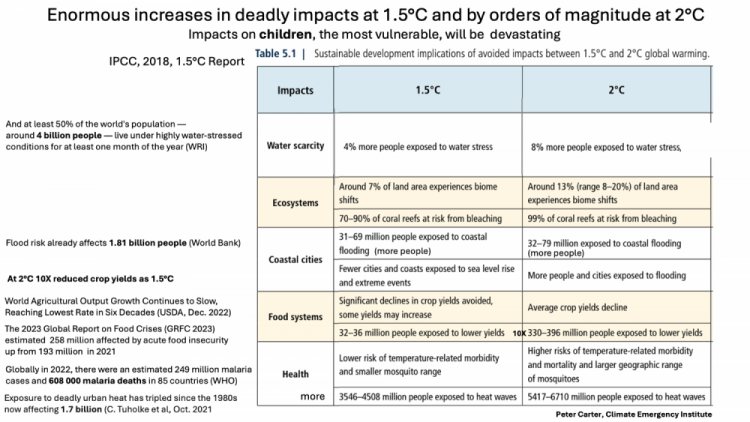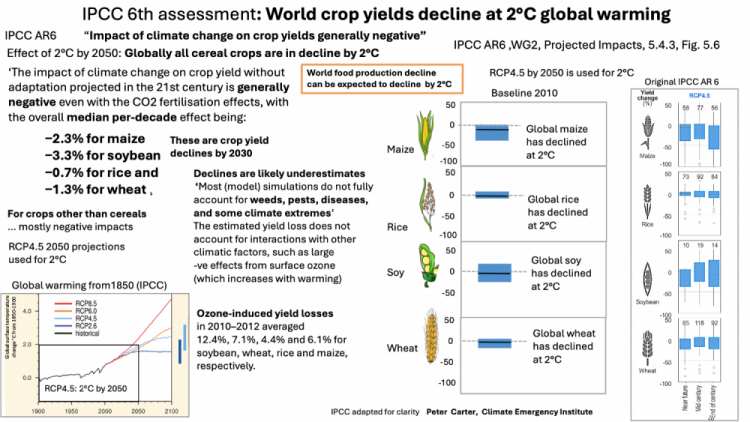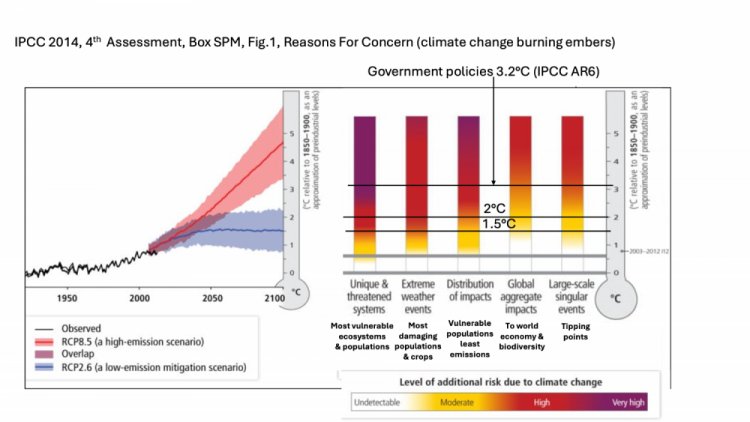The Health and Human Rights Approach to Greenhouse Gas Pollution
Children

Climate Emergency Institute

2023 UN:Urgent action by States needed to tackle climate change, says UN Committee in guidance on children’s rights and environment. This statement encompasses their rights to information, participation, and access to justice to ensure that they will be protected from and receive remedies for the harms caused by environmental degradation and climate change.”
(UN Office of Human Rights, 28 August 2023)
Climate Change & Global Child Health 'climate change transcends geopolitical boundaries and will have extensive impacts on child health and security. With implications for all of humanity, climate change will disproportionately affect children
(UN Office of Human Rights, 28 August 2023)
Climate Change & Global Child Health 'climate change transcends geopolitical boundaries and will have extensive impacts on child health and security. With implications for all of humanity, climate change will disproportionately affect children
Sept 23 2019 Global Youth Climate Action Declaration
Children in all regions are most vulnerable to extreme weather events.
This happening.
Impacts from recent climate-related extremes,
such as heat waves, droughts, floods, cyclones,
and wildfires, reveal significant vulnerability and
exposure of many human systems to current
climate variability.
Impacts of such climate-related extremes include
alteration of ecosystems, disruption of food
production and water supply, damage to
infrastructure and settlements, morbidity
and mortality, and consequences for mental
health and human well-being', which as affected 'countries at all levels of development.
Air pollution from fossil fuel emissions
The global horrendous abuse of many of the world's children today is the damaging air pollution from fossil fuel emissions.
Fossil subsidies: Increased to $7 TRillion/year (IMF)
Greatest criminal evil imaginable Governments are increasing fossil fuel subsidies - now $7 Trillion/year (IMF)
The world has made substantial progress in reducing child mortality in the past several decades. Even so every year, millions of children under 5 years of age die, mostly from pneumonia, diarrhoea and malaria. In almost half of the cases, malnutrition plays a role, with unsafe water a significant factor.
All of these are predicted to increase with global climate change.
Also huge disparities in under-fve mortality exist across regions and countries.
Sept 23 2019 Global Youth Climate Action Declaration
Preserving the world for future generations:
young people’s perspectives on how to tackle climate change
Oct. 2023, Children at ‘existential risk’ from climate crisis, UK’s top paediatrician
Oct. 2023, Children at ‘existential risk’ from climate crisis, UK’s top paediatrician
Children-climate change Royal College of Paediatrics and Child Health (RCPCH)
Harvard Chan School Public health Children and climate change
Increased greenhouse gasses in the atmosphere are leading to higher temperatures, more intense storms, and lengthy droughts—all of which can deeply affect children’s health.
IPCC 2022 6th Assessment question
A summary of the children's climate emergency
Extract: 'Climate Climate change impacts are increasingly being felt in all regions of the world with growing challenges for water availability, food production and the livelihoods of millions of people. We also know that impacts will continue to increase if drastic cuts in greenhouse gas emissions are further delayed – affecting the lives of today’s children tomorrow and those of their children much more than ours'.
Extract: 'Climate Climate change impacts are increasingly being felt in all regions of the world with growing challenges for water availability, food production and the livelihoods of millions of people. We also know that impacts will continue to increase if drastic cuts in greenhouse gas emissions are further delayed – affecting the lives of today’s children tomorrow and those of their children much more than ours'.
UNICEF
“We call on all members of society to join us in a global movement that will help build a world fit for children through upholding our commitments to the following principles and objectives…
“Protect the Earth for children. We must safeguard our natural environment, with its diversity of life, its beauty and its resources, all of which enhance the quality of life, for present and future generations. ( A World Fit for Children, 2002, UN Special Session on Children, 2002)
1.5 to Stay Alive
Under the 2015 UN Paris Agreement nations
committed to the 1.5°C global warming
safety limit, which is now the limit adopted
by climate science, and all parties involved.
Under the 2015 UN Paris Agreement nations
committed to the 1.5°C global warming
safety limit, which is now the limit adopted
by climate science, and all parties involved.
The old (1996) 2°C policy limit would be an
unprecedented crime against the world's
children and humanity (2018 book
Unprecedented Crime...).
IPCC Immediate rapid decline required for 2°C limit as well as 1.5°C
unprecedented crime against the world's
children and humanity (2018 book
Unprecedented Crime...).
IPCC Immediate rapid decline required for 2°C limit as well as 1.5°C
Children in industrially developed countries as well?
Quite rightly all reports stress that the most vulnerable children live in under industrially developed regions where the population is poorest and least to blame for climate change.
However the children of the poorest families everywhere are more vulnerable. Even in the most advantaged developed countries, we have already seen how children are most vulnerable to extreme weather disasters, like heat waves and floods.
IPCC predicts this and other impacts affecting children will increase.
Throughout the 21st century climate-change impacts are projected to:
> slow down economic growth,
> make poverty reduction more difficult,
> further erode food security,
and prolong existing and create new poverty traps, the latter particularly in urban areas and emerging hotspots of hunger.
Climate-change impacts are expected to exacerbate poverty in most developing countries and create new poverty pockets in countries with increasing inequality, in both developed and developing countries. (IPCC)
This is happening
Impacts from recent climate-related extremes, such as heat waves, droughts, floods, cyclones, and wildfires, reveal significant vulnerability and exposure of many human systems to current climate variability.
Impacts of such climate-related extremes include alteration of ecosystems, disruption of food production and water supply, damage to infrastructure and settlements, morbidity and mortality, and consequences for mental health and human well-being', which as affected 'countries at all levels of development. (IPCC)
Food production
At already committed degrees of climate change
all major food producing regions will suffer crop
yield declines with food shortages to which
developing children are most vulnerable.
This has started.
'Based on many studies covering a wide range
of regions and crops, negative impacts of climate
change on crop yields have been more common
than positive impacts' (IPCC)
However the children of the poorest families everywhere are more vulnerable. Even in the most advantaged developed countries, we have already seen how children are most vulnerable to extreme weather disasters, like heat waves and floods.
IPCC predicts this and other impacts affecting children will increase.
Throughout the 21st century climate-change impacts are projected to:
> slow down economic growth,
> make poverty reduction more difficult,
> further erode food security,
and prolong existing and create new poverty traps, the latter particularly in urban areas and emerging hotspots of hunger.
Climate-change impacts are expected to exacerbate poverty in most developing countries and create new poverty pockets in countries with increasing inequality, in both developed and developing countries. (IPCC)
This is happening
Impacts from recent climate-related extremes, such as heat waves, droughts, floods, cyclones, and wildfires, reveal significant vulnerability and exposure of many human systems to current climate variability.
Impacts of such climate-related extremes include alteration of ecosystems, disruption of food production and water supply, damage to infrastructure and settlements, morbidity and mortality, and consequences for mental health and human well-being', which as affected 'countries at all levels of development. (IPCC)
Food production
At already committed degrees of climate change
all major food producing regions will suffer crop
yield declines with food shortages to which
developing children are most vulnerable.
This has started.
'Based on many studies covering a wide range
of regions and crops, negative impacts of climate
change on crop yields have been more common
than positive impacts' (IPCC)
Children in all regions are most vulnerable to extreme weather events.
This happening.
Impacts from recent climate-related extremes,
such as heat waves, droughts, floods, cyclones,
and wildfires, reveal significant vulnerability and
exposure of many human systems to current
climate variability.
Impacts of such climate-related extremes include
alteration of ecosystems, disruption of food
production and water supply, damage to
infrastructure and settlements, morbidity
and mortality, and consequences for mental
health and human well-being', which as affected 'countries at all levels of development.
Diseases
Communicable diseases have already started to spread from tropical regions to the more wealthy temperate regions, and new diseases are predicted has started, and in the future can affect all countries.
Displacement
Climate change is already increasing the number of refugees, with children most at risk.
Conflict
Climate change driven conflict (a cause of refugees) as long predicted is happening and in the future can affect most countries.
Climate change can indirectly increase risks of violent conflicts in the form of civil war and inter-group violence by amplifying well-documented drivers of these conflicts such as poverty and economic shocks. Multiple lines of evidence relate climate variability to these forms of conflict
Adaptation
Adaptation measures are essential to start working on for all countries, and mainly consists of upgrading public services, which applies to most if not all countries. Adaptation is least likely to benefit children due to their high vulnerability. Limits to adaptation emerge from the interaction among climate change and biophysical and/or socioeconomic constraints.
Opportunities to take advantage of positive synergies between adaptation and mitigation may decrease with time, particularly if limits to adaptation are exceeded. In some parts of the world, insufficient responses to emerging impacts are already eroding the basis for sustainable development.
Liveable future
Displacement
Climate change is already increasing the number of refugees, with children most at risk.
Conflict
Climate change driven conflict (a cause of refugees) as long predicted is happening and in the future can affect most countries.
Climate change can indirectly increase risks of violent conflicts in the form of civil war and inter-group violence by amplifying well-documented drivers of these conflicts such as poverty and economic shocks. Multiple lines of evidence relate climate variability to these forms of conflict
Adaptation
Adaptation measures are essential to start working on for all countries, and mainly consists of upgrading public services, which applies to most if not all countries. Adaptation is least likely to benefit children due to their high vulnerability. Limits to adaptation emerge from the interaction among climate change and biophysical and/or socioeconomic constraints.
Opportunities to take advantage of positive synergies between adaptation and mitigation may decrease with time, particularly if limits to adaptation are exceeded. In some parts of the world, insufficient responses to emerging impacts are already eroding the basis for sustainable development.
Liveable future
With current unprecedented accelerating global climate change indicators and, increasing record emissions and no international action to put global emissions into rapid decline, a question exists of whether today's children have a liveable future
Air pollution from fossil fuel emissions
The global horrendous abuse of many of the world's children today is the damaging air pollution from fossil fuel emissions.
UNICEF Climate change is contributing to a growing water crisis and putting the lives of millions of children at risk. By 2040 1 in 4 children are projected to be living in areas of extremely high water stress (March 2017, Thirsting for a Future).
Fossil subsidies: Increased to $7 TRillion/year (IMF)
Greatest criminal evil imaginable Governments are increasing fossil fuel subsidies - now $7 Trillion/year (IMF)
Children are most vulnerable because:
1. Children are most vulnerable to the toxic particulates and chemicals emitted from fossil fuel combustion (air pollution). These air pollution effects will be increased by global climate change.
2. Children are also most vulnerable to all impacts of global climate change, in industrially developed as well as developing countries.
3. Today's children inherit a very different 'inhospitable planet' Earth due to current and already committed greater degrees of climate change.The most climate change vulnerable countries India, Pakistan, Philippines Bangladesh (in that order).
3. Today's children inherit a very different 'inhospitable planet' Earth due to current and already committed greater degrees of climate change.The most climate change vulnerable countries India, Pakistan, Philippines Bangladesh (in that order).
Climate change will exacerbate ongoing causes of morbidity and mortality amongst children.
The world has made substantial progress in reducing child mortality in the past several decades. Even so every year, millions of children under 5 years of age die, mostly from pneumonia, diarrhoea and malaria. In almost half of the cases, malnutrition plays a role, with unsafe water a significant factor.
All of these are predicted to increase with global climate change.
Also huge disparities in under-fve mortality exist across regions and countries.
28 Sept 2020 Africa Climate Change Impacts, Trends and Vulnerabilities of Children in Sub Saharan Africa
Lancet Nov. 2019
Ensuring that the health of a child born today is not defined by a changing climate
Oct 2019 UNICEF State of the World Children Food & Nutrition: 149 million
children aged under 5 still suffer from stunting and almost 50 million
from wasting; 340 million children suffer from the hidden hunger of
deficiencies of vitamins and minerals. Climate change features.
2020 World Bank Climate change on poverty 32 million people will be forced into poverty through climate change in 2030. Over 100 million people if no speedy action
2024 AAP Child-climate change Policy statement
American Academy of Pediatrics Climate Change and Global Child Health (see to governments)
THE IMPACT OF THE ENVIRONMENT ON CHILDREN’S HEALTH
It needs to be recognized that the worst pollution by far is fossil fuel pollution- air pollution and greenhouse gas pollution.
It needs to be recognized that the worst pollution by far is fossil fuel pollution- air pollution and greenhouse gas pollution.
August 2nd 2016, UN Climate change Secretariat: children and climate change
Climate Change Mainly Impacting Vulnerable Children
20 August 2021 UNFCCC One Billion Children at ‘Extremely High Risk’ of the Impacts of the Climate Crisis
UNFCCC Resources for youth
Climate Change Mainly Impacting Vulnerable Children
20 August 2021 UNFCCC One Billion Children at ‘Extremely High Risk’ of the Impacts of the Climate Crisis
UNFCCC Resources for youth
Gender
The vulnerability of babies and small children is linked to the vulnerability of women in poor and developing countries, as they are the child bearers and main care.
givers.
The vulnerability of babies and small children is linked to the vulnerability of women in poor and developing countries, as they are the child bearers and main care.
givers.
UN, 2002, World fit for Children
“We call on all members of society to join us in a global movement that will help build a world fit for children through upholding our commitments to the following principles and objectives…
“We call on all members of society to join us in a global movement that will help build a world fit for children through upholding our commitments to the following principles and objectives…
“Protect the Earth for children. We must safeguard our natural environment, with its diversity of life, its beauty and its resources, all of which enhance the quality of life, for present and future generations".
( A World Fit for Children, 2002, UN Special Session on Children, 2002)
UN 1989 Convention on Rights of the Child (about)
The Text
( A World Fit for Children, 2002, UN Special Session on Children, 2002)
UN 1989 Convention on Rights of the Child (about)
The Text
28 Mar 2017 Actuaries Climate Change and Mortality, by Actuaries
(references children)
(references children)

Impacts at 1.5°C and 2°C
from 2018 IPCC 1.5C report
from 2018 IPCC 1.5C report

Decline in crop yields at 1.5°C and 2°C
IPCC 2022 6th assessment
IPCC 2022 6th assessment

IPCC Rising risks of severe impacts
with warming
with warming